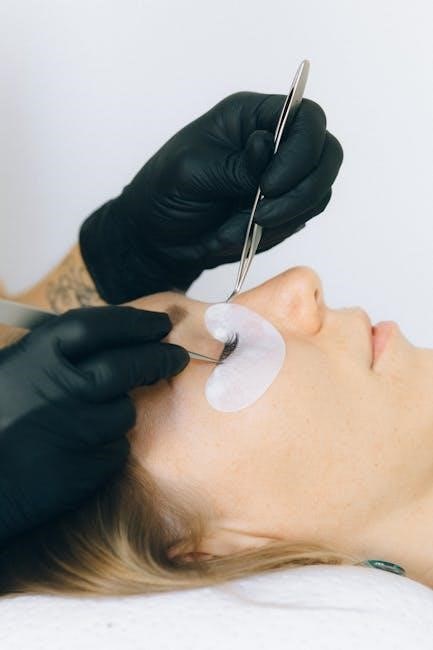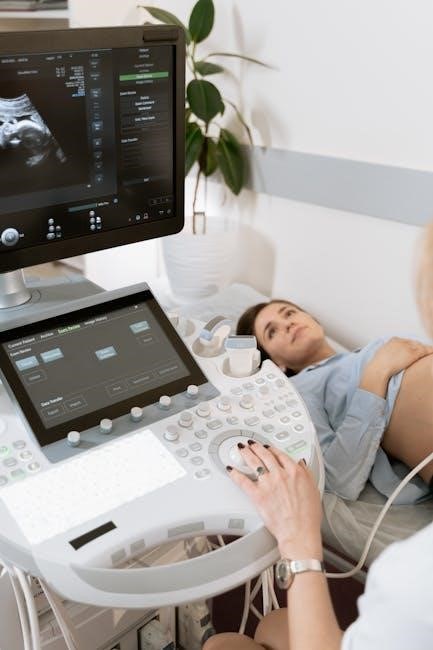The temporomandibular joint (TMJ) is a critical joint connecting the jawbone to the skull, enabling functions like chewing, speaking, and yawning. TMJ disorders, or TMD, can cause pain, limited jaw movement, and discomfort, affecting millions worldwide. Understanding this condition is essential for effective management and improving quality of life.
1.1 What is the Temporomandibular Joint (TMJ)?
The temporomandibular joint (TMJ) is a bilateral joint connecting the mandible (jawbone) to the skull, located just in front of the ears. It functions as a hinge and gliding joint, enabling essential movements like chewing, speaking, and yawning. Each TMJ contains a cartilage disc that reduces friction and facilitates smooth motion. The joint’s proper functioning is crucial for oral health and overall comfort.
1.2 Overview of TMJ Disorders
TMJ disorders, or TMD, involve pain and dysfunction in the jaw joint and surrounding muscles. Common manifestations include jaw pain, clicking, locking, and limited movement. These conditions can arise from issues like disk displacement, arthritis, or bruxism. While symptoms may be mild for some, others experience severe discomfort requiring medical intervention. Proper diagnosis and treatment are essential for managing TMJ disorders effectively.
1.3 Importance of Patient Education
Patient education is crucial for managing TMJ disorders. Informed patients can recognize early symptoms, adopt preventive measures, and adhere to treatment plans. Education empowers individuals to understand their condition, make informed decisions, and collaborate with healthcare providers effectively. This proactive approach enhances recovery and improves overall quality of life for those affected by TMJ disorders.

Common Symptoms of TMJ Disorders
TMJ disorders often present with jaw pain, clicking or locking, limited movement, and ear discomfort. These symptoms can significantly impact daily activities and overall well-being.
2.1 Jaw Pain and Tenderness
Jaw pain and tenderness are hallmark symptoms of TMJ disorders. Patients often experience discomfort in the jaw joint or surrounding muscles, especially during activities like chewing or speaking. This pain can range from mild to severe and may radiate to the face or temples, impacting daily life and requiring prompt attention for effective management.
2.2 Clicking or Locking of the Jaw
Clicking or locking of the jaw is a common symptom of TMJ disorders. Patients may experience a clicking sound when opening or closing the mouth, while locking occurs when the jaw gets stuck in one position. This can disrupt daily activities like eating or speaking. Clicking may be occasional and harmless, but persistent or severe cases often require professional evaluation to address underlying issues and prevent further complications;
2.3 Limited Jaw Movement
Limited jaw movement is a common symptom of TMJ disorders, making it difficult to open the mouth fully or perform normal functions like chewing or speaking. This restriction can result from inflammation, muscle tension, or structural issues within the joint. Patients may struggle with daily activities, and severe cases can significantly impact quality of life, often requiring professional evaluation to restore normal jaw function and comfort.
2.4 Ear Pain or Fullness
Ear pain or fullness is a common symptom of TMJ disorders, often due to the proximity of the TMJ to the ear. This can result in referred pain, making it feel like the ear is the source of discomfort. Symptoms may include a sensation of fullness, muffled hearing, or sharp pains, which can sometimes be mistaken for ear infections. Consulting a healthcare professional is crucial for accurate diagnosis and relief.
2.5 Emotional and Psychological Effects
TMJ disorders can have profound emotional effects, including increased stress, anxiety, and frustration due to chronic pain and discomfort. The persistent nature of symptoms may lead to feelings of hopelessness or low mood, impacting daily life and relationships. Addressing these psychological aspects is essential for comprehensive management and improving overall well-being.

Causes and Risk Factors
TMJ disorders arise from factors like disk displacement, arthritis, bruxism, and trauma. These conditions disrupt joint alignment and function, leading to pain and limited movement.
3.1 Disk Displacement
Disk displacement occurs when the cartilage cushion within the TMJ shifts out of position, disrupting joint alignment. This can cause clicking, locking, or pain during jaw movements. Over time, chronic displacement may lead to inflammation and degeneration, worsening symptoms and requiring targeted treatment to restore proper joint function and alleviate discomfort.
3.2 Arthritis and Inflammatory Conditions
Arthritis and inflammatory conditions, such as osteoarthritis or rheumatoid arthritis, can affect the TMJ, leading to pain, swelling, and limited jaw movement. These conditions cause inflammation and degeneration of the joint tissues, potentially resulting in chronic discomfort and impaired function. Proper diagnosis and treatment are essential to manage symptoms and prevent further joint damage, improving overall quality of life for patients.
3.3 Bruxism (Teeth Grinding)
Bruxism, or teeth grinding, is a common habit that can strain the TMJ, leading to pain, jaw tenderness, and limited movement. Often occurring during sleep, it can cause microtrauma to the joint and surrounding muscles. Addressing bruxism through behavioral changes, relaxation techniques, or dental appliances is crucial to prevent long-term damage and alleviate TMJ-related discomfort, ensuring better oral and overall health.
3.4 Trauma or Injury
Trauma or injury to the jaw or face can directly impact the TMJ, leading to pain, dysfunction, or misalignment. Falls, car accidents, or blunt force can cause fractures, disc displacement, or inflammation. Even minor injuries may trigger chronic TMJ issues over time. Proper evaluation and treatment are essential to prevent long-term complications and restore normal jaw function and comfort.

Diagnosis of TMJ Disorders
Diagnosis involves a comprehensive clinical examination, imaging techniques, and patient history to identify joint and muscle dysfunction, ensuring accurate identification of TMJ-related issues.
4.1 Clinical Examination
A comprehensive clinical exam assesses jaw function, tenderness, and movement. It includes evaluating:
- Jaw alignment and range of motion
- Pain during palpation of the TMJ and muscles
- Clicking or locking of the jaw
- Muscle function and bite alignment
This step is crucial for diagnosing TMJ disorders accurately.
4.2 Imaging Techniques
Imaging techniques are essential for diagnosing TMJ disorders, providing detailed visuals of the joint’s internal structures. Common methods include:
- Magnetic Resonance Imaging (MRI): Offers detailed images of soft tissues, including the articular disc.
- Computed Tomography (CT) scans: Provide clear images of bone structures around the TMJ.
- Panoramic X-rays: Show the overall structure of the jaw and joint.
These imaging tools help in identifying abnormalities, guiding accurate diagnosis and treatment planning.
4.3 TMJ Arthroscopy
TMJ arthroscopy is a minimally invasive surgical procedure used to diagnose and treat joint abnormalities. A small camera and surgical tools are inserted through tiny incisions to examine the joint internally. This technique helps identify issues like inflammation, scar tissue, or disk displacement. It may also be used to remove debris or irrigate the joint, providing relief from pain and improving function. It’s often recommended when conservative treatments fail.

Non-Surgical Treatment Options
Non-surgical treatments for TMJ disorders focus on pain relief and improved function. Common approaches include home care, splint therapy, physical therapy, and medications for managing symptoms effectively.
- Home care: Jaw rest, ice therapy, and soft diet
- Splint therapy: Custom appliances to reduce strain
- Physical therapy: Exercises for jaw mobility and relaxation
- Medications: Pain relievers and muscle relaxants
5.1 Home Care and Self-Management
Home care and self-management are essential for alleviating TMJ symptoms. Patients can adopt strategies like jaw rest, soft diet, and avoiding excessive chewing. Applying ice or heat packs can reduce pain and inflammation. Gentle jaw exercises, relaxation techniques, and stress management also help. Proper posture and avoiding harmful habits, such as teeth grinding, can prevent further discomfort. Regular follow-ups with a healthcare provider are recommended for monitoring progress.
5.2 Splint Therapy
Splint therapy involves using a custom-fitted dental appliance to stabilize the jaw and reduce strain on the TMJ. It is a non-invasive treatment option often recommended for patients with disc displacement or severe jaw pain. The splint helps reposition the jaw, alleviating discomfort and promoting proper alignment. Regular use can significantly reduce symptoms like clicking, locking, and pain, improving overall jaw function and quality of life for patients.
5.3 Physical Therapy
Physical therapy is a conservative approach to managing TMJ disorders, focusing on exercises to improve jaw mobility and strength. Techniques like heat therapy, massage, and gentle exercises can help reduce muscle tension and pain. Customized therapy plans aim to restore normal jaw function, alleviate discomfort, and enhance overall quality of life for patients with TMJ-related issues.
5.4 Medications for Pain Management
Medications play a key role in managing TMJ disorder symptoms. Over-the-counter pain relievers like NSAIDs (e.g., ibuprofen) reduce inflammation and pain. Muscle relaxants and corticosteroids may be prescribed for severe cases. Topical anesthetics can provide localized relief. In some cases, antidepressants or neuropathic pain medications are used to address chronic pain. Always consult a healthcare provider before starting any medication to ensure safety and effectiveness.

Surgical Treatment Options
Surgical options for TMJ disorders include arthrocentesis, arthroscopy, and open joint surgery, offering solutions for severe cases where conservative treatments have failed to provide relief.
6.1 Arthrocentesis
Arthrocentesis is a minimally invasive procedure involving the insertion of needles to flush the TMJ with sterile fluid, removing inflammatory byproducts and debris. This technique aims to reduce pain, improve joint mobility, and restore function. It is often recommended for patients with disc displacement or chronic inflammation who have not responded to conservative treatments. The procedure is relatively quick and can provide significant relief for eligible candidates.
6.2 TMJ Arthroscopy
TMJ arthroscopy is a minimally invasive surgical procedure that uses a small camera and surgical instruments to visualize and treat joint abnormalities. A cannula is inserted into the joint space to identify inflammation, scar tissue, or disc issues. This technique allows for both diagnosis and treatment, such as removing debris or releasing adhesions, promoting healing and restoring function. It is often recommended for chronic or severe cases unresponsive to other treatments.
6.3 Open Joint Surgery
Open joint surgery is a more invasive procedure reserved for severe TMJ cases where non-surgical treatments fail. It involves making an incision to directly access the TMJ, allowing surgeons to repair or replace damaged structures like the joint disk or bone. This approach is often used for significant joint damage, chronic pain, or structural issues. Recovery may require longer downtime and physical therapy to restore jaw function and alleviate pain.
6.4 Joint Replacement
TMJ joint replacement involves surgically replacing the damaged joint with an artificial one, typically made of titanium or biocompatible materials. This procedure is considered for severe cases where the TMJ is irreparably damaged, causing chronic pain or loss of function. Joint replacement aims to restore jaw movement, alleviate pain, and improve quality of life. Modern prosthetics are durable and designed to mimic natural joint function, offering long-term relief for patients.

Lifestyle Management for TMJ Health
Lifestyle adjustments, such as diet modifications and stress reduction, play a crucial role in managing TMJ symptoms and improving overall well-being. These changes help prevent flare-ups and enhance quality of life.
7.1 Diet and Nutrition
A balanced diet rich in nutrients supports TMJ health. Soft foods like soups, yogurt, and cooked vegetables reduce jaw strain. Avoiding chewy, hard, or sticky foods can prevent discomfort. Staying hydrated and limiting caffeine and alcohol intake also help manage symptoms. A tailored dietary plan can reduce inflammation and promote healing, aiding in overall TMJ well-being and recovery.
7.2 Stress Management
Stress can exacerbate TMJ symptoms, leading to jaw clenching and grinding. Techniques like mindfulness, meditation, and deep breathing can reduce tension. Regular exercise and relaxation exercises also help manage stress levels. A calm mental state contributes to less jaw strain, promoting overall TMJ health and well-being.
7.3 Postural Awareness
Good posture is essential for TMJ health, as misalignment can strain the jaw muscles. Keeping the head upright, shoulders relaxed, and neck in neutral alignment reduces TMJ pressure. Ergonomic adjustments and awareness of daily postures can prevent unnecessary strain, promoting comfort and reducing pain. Regular reminders to check posture can help maintain a healthy TMJ and overall musculoskeletal balance.

When to See a TMJ Specialist
Consult a TMJ specialist if symptoms persist, worsen, or interfere with daily life. Severe pain, limited jaw movement, or failed conservative treatments warrant specialized care.
8.1 Severe or Persistent Symptoms
Severe or persistent symptoms, such as intense jaw pain, locking, or limited movement, require immediate attention. These signs may indicate advanced TMJ issues that need specialized evaluation and treatment to prevent further complications and improve quality of life.
8.2 Failed Conservative Treatments
If home care, splints, or physical therapy fail to alleviate TMJ symptoms, further investigation is necessary; Persistent pain or dysfunction despite conservative measures may signal the need for advanced treatments, including arthroscopy or surgery, to address underlying structural issues and restore proper joint function.
8.3 Complex Cases and Surgery
Complex TMJ cases often involve severe structural damage, chronic pain, or significant functional impairment. Surgery, such as arthroscopy or joint replacement, may be recommended when non-surgical options are ineffective. These procedures aim to repair or replace damaged components, restore joint function, and alleviate pain, offering a long-term solution for patients with advanced TMJ disorders.

Patient Resources and Support
Access to educational materials, support groups, and online forums can empower TMJ patients to manage their condition effectively and connect with others facing similar challenges, fostering hope and understanding.
9.1 Educational Materials
Educational materials provide patients with comprehensive information about TMJ disorders, symptoms, diagnosis, and treatment options. These resources, often in the form of leaflets or guides, explain the condition clearly, addressing frequently asked questions and offering practical advice. They empower patients to understand their diagnosis, make informed decisions, and actively participate in their care. Many materials also include tips for managing symptoms and improving quality of life.
9.2 Support Groups
Support groups offer a platform for TMJ patients to share experiences, challenges, and coping strategies. These groups, either in-person or online, provide emotional support, practical advice, and a sense of community. Patients can connect with others facing similar issues, reducing feelings of isolation. Additionally, many groups are moderated by healthcare professionals, ensuring access to accurate information and guidance.
9.3 Online Communities and Forums
Online communities and forums provide valuable resources for TMJ patients, offering a space to share experiences, ask questions, and gather advice. Many forums are moderated by healthcare professionals, ensuring reliable information. Patients can connect with others worldwide, reducing feelings of isolation. These platforms also offer access to educational materials, treatment options, and personal stories, fostering a supportive environment for those managing TMJ disorders.
Understanding TMJ disorders is key to effective management. By addressing symptoms, seeking professional advice, and adopting proactive care, patients can improve their quality of life and jaw function.

10.1 Summary of Key Points
TMJ disorders affect the jaw joint and surrounding muscles, causing pain and limited movement. Understanding causes, such as disk displacement or arthritis, is crucial. Early diagnosis through clinical exams or imaging can lead to effective treatments, including self-care, splints, or surgery. Managing lifestyle factors like diet and stress, along with seeking specialist care when needed, enhances outcomes. Patient education and proactive care are vital for improving quality of life and jaw function.
10.2 Encouragement for Proactive Care
Proactive care is essential for managing TMJ disorders. Patients are encouraged to adopt healthy habits, such as maintaining a soft diet, practicing stress reduction techniques, and avoiding jaw-straining activities. Regular follow-ups with healthcare providers and open communication about symptoms can significantly improve outcomes. Taking charge of your care demonstrates commitment to long-term well-being and jaw health, empowering you to lead a pain-free life.

